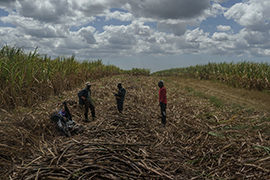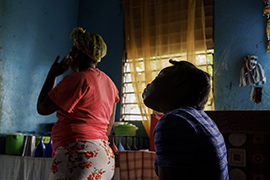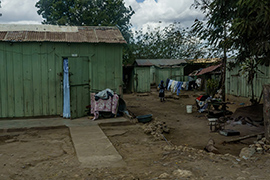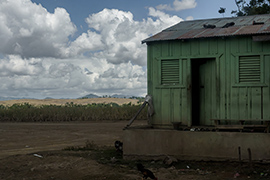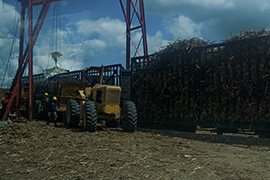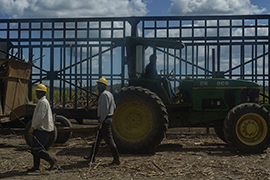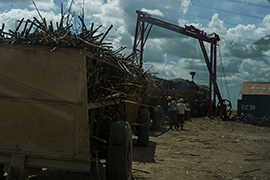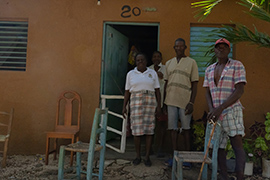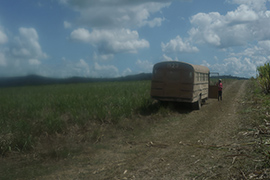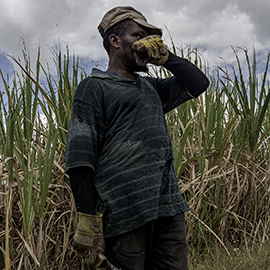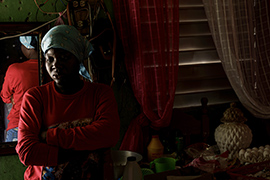- Slug: BC-CNS-Borderlands Embargo,2210 words.
- 13 photos, graphic available (embed cod, thumbnails, captions below).
By John Leos
Cronkite Borderlands Initiative
Multiple workers reported that agents of Central Romana warned residents in the bateyes against speaking to journalists under threat of forced eviction. For this reason, personal identifying information has been removed and names of workers have been changed for protection. “They don’t want us to talk, but our life is not good.” – Central Romana employee
LA ROMANA, Dominican Republic – A row of small concrete homes sits secluded among towering fields of sugar cane and crisscrossing dirt roads. Young children play under the sparse shade of trees while exhausted women hang the wash to dry under the sweltering Dominican sun – and under the control of the country’s largest corporation.
Marie, 36, lives with her husband and five children in one of these houses. The dimly lit three-room structure is caked in dirt on the outside, but the inside is filled with piles of her children’s clothes and the smell of reheated rice. Seven people occupy the home, but none are authorized to live in the Dominican Republic.
They are among the thousands of workers tending fields owned by Central Romana Corp. They live in a company town— known locally as a batey — that is also owned by their employer.
Central Romana owns Marie’s house. It provides her family’s sole source of income. It runs the schools that educate her children and offers her the only refuge from Dominican immigration authorities.
Marie has lived here since 2005 without legal documents. Her children were born into statelessness. Her husband has a severe physical disability, but he still spends 12 hours a day, six days a week, in the sugar cane fields cutting the heavy stalks by the metric ton in order to earn a meager wage of 50 cents an hour, an income she reports as shrinking.
“It’s not enough for eating,” she said. “We are seven people living here. You can imagine what this means for us.”
Marie wants to find work herself and contribute to the family’s earnings, but her undocumented status keeps her confined to the home. She yearns for a better future for her children, but there isn’t much room for hope. Her oldest daughter will soon age out of the nearby school, and the intermediate school outside of the settlement requires papers.
The neighbor next door was recently evicted from his home by Central Romana because he was unable to work. Marie fears her family could be next.
The last time she went to the market in the nearby town of Guaymate, she witnessed immigration agents grabbing Haitian people off the streets. She ran through the market so she wouldn’t be caught, but later, two others were captured in the settlement.
“The fear that undocumented people have is high now,” she said, “You cannot be free in the batey.”
Marie and her family’s survival reflect the thousands of other Haitian and stateless people of Haitian descent living and working on Central Romana’s land amid an embargo on the corporation’s sugar products by the United States government.
By law, the United States is prohibited from importing goods produced by forced labor.
In November 2022, the U.S. Customs and Border Protection announced that it would be enforcing an order halting products that originated from Central Romana’s plantations from being imported to the United States.
The order came after federal investigators found forced labor practices on Central Romana’s plantations and worker housing following a formal petition from international advocates.
The corporation, owned in part by the Florida based Fanjul Corp., denied all allegations of workers’ rights violations in a statement issued after the embargo was enacted.
“In the coming weeks and months, we expect to engage in a dialogue with CBP about the issues they have raised, and we will share our position fully and transparently. We hope to be able to work collaboratively with CBP to resolve this matter,” said Central Romana in the statement.
In the meantime, diminishing wages, forced evictions and immigration raids have left Central Romana’s largely Haitian workforce even more vulnerable.
Evictions and Demolition
Etienne, 71, sits in a weathered wooden chair outside a dilapidated brown house in a row of identical brown houses with hand scrawled numbers painted above each door. There are power lines running by this and other Central Romana properties, but none are connected to the electrical grid. The houses also lack running water.
Etienne, a short, soft-spoken elder, brushes his hands over his salt-and-pepper hair as he describes being evicted from his home by Central Romana three months earlier.
The corporation demolished his settlement, called Batey Nigua, or “flea batey,” one month after the embargo was enacted. Other residents were put on buses and spread out to other company towns. Because he had family in this settlement, Etienne moved here.
Central Romana has a pattern of forcefully displacing its employees living in company housing.
In 2021, after an investigation by Mother Jones revealed negligible living conditions, the company bulldozed a settlement known as Batey Hoyo de Puerco, or “Pighole Batey,” ahead of a U.S. congressional delegation visit to La Romana province. Central Romana denied the timing of the demolition was related to the visit.
In 2020, Central Romana and Fanjul Corp. were sued in U.S. federal court by 24 families after the destruction of a settlement in El Seibo province. The residents allege that in 2016, armed militarized guards working for Central Romana forced them from their homes and demolished entire settlements in the middle of the night, without any prior notice.
The lawsuit was dismissed in 2021. The court’s opinion cited a lack of subject matter jurisdiction. The lawyer for these families, Robert T. Vance Jr., is the same lawyer that filed the official petition with CBP to enforce the embargo against Central Romana.
For now, Etienne resides at his brother’s house, where he has become completely dependent on his family. He requested a pension from the Dominican government in 2008, but never received a response.
The only document he has is a Central Romana worker identification card.
Etienne immigrated to the Dominican Republic in 1975, when he was 23 years old, escaping Haiti’s political and economic turmoil. As soon as he set foot in La Romana province, he began working in the canefields cleaning weeds and cutting cane.
Now, Etienne suffers from vision loss and high blood pressure from Type II diabetes, which has made it impossible for him to return to work without putting his life at risk. If Central Romana officials catch him living on company property without working, he fears he will be evicted again.
“They are abusing Haitians now,” said Etienne, “They are saying it’s because of Haitians that there is an embargo with the United States.”
Prohibitions and politics
The United States is prohibited from importing goods produced under forced labor practices under Section 307 of the Tariff Act of 1930. In 2022, the Law Offices of Robert T. Vance Jr., a Philadelphia-based firm, filed a petition under Section 307 with the U.S. Customs and Border Protection to cease imports from Central Romana.
“CBP receives numerous allegations of forced labor from a variety of sources, including government partners, reports by non-government organizations, media coverage, firsthand accounts and the general public,” said Jeffrey Quiñones, an agency representative, in a written statement. “We will continue to use the resources at our disposal to evaluate these allegations and to identify and prevent goods made with forced labor from entering the U.S. commerce.”
CBP did not provide the details on the inception of the investigation, but a congressional delegation visit to the Dominican Republic, a Department of Labor report and negative reports from human rights advocates all happened in the months leading up to the embargo.
In a meeting of the House Ways and Means Subcommittee on Trade in 2021, Rep. Earl Blumenaur, D-Ore., also cited reports by The Washington Post into dubious financial practices by Central Romana leadership and a two-year investigation by Mother Jones and the Center for Investigative Reporting.
A subsequent investigation by CBP found five of the International Labor Organization’s indicators of forced labor in Central Romana’s operations, including isolation, withholding of wages, abusive working and living conditions, and the exploitation of people in a vulnerable position.
In response, the Dominican government sought to help Central Romana by engaging in a dialogue with U.S. officials to reverse the sanction. The Ministries of Labor, Foreign Affairs, and Industry and Commerce have been employed to monitor the situation, according to presidential representative Homero Figuero.
“We understand that the decision to suspend imports to the United States of sugar produced by Central Romana has nothing to do with the role of the Dominican Government,” said Figueroa in a statement on Nov. 25, 2022, “but since it affects the international image and the country’s economy, we have to get involved. We want to do it in a constructive way.”
Central Romana cane workers and human rights advocates fear that political pressure from the Dominican government could lead to the order being lifted without any substantive changes to working conditions. Dominican officials did not comment on the status of the governmental commission, or how they were engaging with U.S. officials.
“CBP will not modify or revoke a WRO (withhold release order) until all the indicators of forced labor identified by the agency are sufficiently addressed and when it is satisfied that forced labor is no longer being used to produce the goods targeted by the order,” CBP’s Quiñones said in a written statement.
Machetes and the sugar economy
A repurposed school bus waits at the edge of a seemingly endless canefield to transport Central Romana’s workers back home to company housing after the workday’s end. Among the piles of dead stalks and swinging machetes is Jean-Baptiste, who wipes the sweat from his brow after boasting that he can harvest one ton of sugar cane in an hour. He earns $55 a week for this labor.
Jean-Baptiste immigrated to the Dominican Republic from Thiotte, Haiti, in 2009 with hopes of a stable economic future after working as a taxi driver in the poorest country in the Western Hemisphere. He is now the father to three children, all living on Central Romana’s property without documents. Just days earlier, he witnessed two of his friends apprehended by Dominican immigration officials and sent to a detention center.
Jean-Baptiste said he knew an embargo was enacted, but did not know the motivations behind the decision.
“We are in misery here, but we prefer to come here,” said Jean-Baptiste before disappearing into the thick of the sugar cane, machete in hand.
Central Romana is the Dominican Republic’s largest private landowner and the biggest employer in the country, accounting for about 70% of total sugar production in the country, according to the company’s website.
Nearly every granule of raw sugar officially exported from the Dominican Republic in 2022 ended up in the United States, according to a report from the U.S. Department of Agriculture. Over the last five years, the U.S. has bought more than half a billion dollars worth of crude and refined sugar from Dominican sugar producers, according to data from INAZUCAR, a Dominican governmental body that makes domestic policy recommendations on sugar production.
The United States imports raw sugar and sugar products under a quota system that guarantees relatively low tariffs. In 2022, the Dominican Republic was allocated the largest share of these quotas among 40 exporting countries, according to data from the U.S. Office of the Trade Representative. By the end of fiscal year 2022 that share had grown to over 20%, one-fifth of all sugar products imported under reduced tariffs, according to the USDA.
More than half of that allocation was filled by Central Romana: 150,347 metric tons of sugar entered the United States in 2022 under what is now classified as forced labor.
The North American market is critical for the Dominican Republic’s trade balance, said Isaac Terrero Sánchez, the director of studies and sugar policies at INAZUCAR. “The livelihoods of over 40,000 employees depend directly on the production of sugar.”
Following the announcement of the embargo, Dominican officials at INAZUCAR reassigned Central Romana’s trade quotas to the other two major sugar producers on the island, Consorcio Azucarero Central and Consorcio Azucarero de Empresas Industriales. The two companies have faced allegations of worker rights abuses similar to Central Romana.
Amid diminishing wages, increasing immigration raids, and the fear of forced eviction, some sugar cane workers said they still support the economic sanction against Central Romana. They believe that the economic pressure will finally lead to accountability for the company.
A cycle of vulnerability
In a cramped and darkened two-room row house, a newborn baby sleeps quietly with her young mother and uncle by her side. Esther, 17, gave birth in a Dominican hospital one month earlier but received no birth certificate for her daughter, Rosa.
Esther was born and raised in this same settlement after her father immigrated to the Dominican Republic from Haiti to work as a cane cutter for Central Romana. Last year, she applied for her own legal documentation, and was even photographed and fingerprinted by Dominican officials. But she never heard back about the status of her application.
Both mother and daughter were born stateless in the Dominican Republic.
Barely a month old, Rosa represents the hope and motivation for her mother to break free from the cycle of vulnerability that has existed in this impoverished settlement for three generations.
“When I get my papers, I want to work in a hotel,” she said watching the dozing child, “I want to help my baby, I want to help my family.”
– Cronkite Borderlands Project is a multimedia reporting program in which students cover human rights, immigration and border issues in the U.S. and abroad in both English and Spanish.
For more stories from Cronkite News, visit cronkitenews.azpbs.org.
^__=
Graphic embed code: <div class=”flourish-embed” data-src=”story/1893077″><script src=”https://public.flourish.studio/resources/embed.js”></script></div>
^__=
Three workers stand in a clearing surrounded by sugar cane stalks ready for harvest in La Romana province, Dominican Republic, in March. Before the U.S. ordered an embargo on Central Romana’s sugar due to forced labor conditions, much of the sugar harvested in these fields would have been exported to the United States under low tariffs. (Photo by John Leos/Cronkite Borderlands Project)
Marie, 36, and her oldest daughter, 13, live in Central Romana company housing in La Romana province in the Dominican Republic. The family of seven depend on a single salary from the Dominican Republic’s largest sugar producer, but income for Marie’s husband has been decreasing since the United States ordered a halt on imports due to forced labor conditions. (Photo by John Leos/Cronkite Borderlands Project)
A woman hangs laundry to dry in a worker settlement, known as a batey, owned by Central Romana. The corporation owns hundreds of settlements throughout their plantations, many of which are dilapidated without running water, electricity or adequate housing for the worker population. (Photo by John Leos/Cronkite Borderlands Project)
A wooden company house sits next to fields where cane workers spend much of the harvesting season cutting sugar cane stalks for Central Romana Corp. Workers who live in the company’s housing have accused the corporation of sudden, violent evictions and demolition of homes. (Photo by John Leos/Cronkite Borderlands Project)
Workers load tons of sugar cane onto railway cars set for processing in Central Romana’s sugar mills in La Romana province, Dominican Republic on March 6, 2023. Central Romana is the largest employer and largest landowner in the country, according to the company’s website. (Photo by John Leos/Cronkite Borderlands Project)
Workers for Central Romana work to load tons of harvested sugar cane onto railway cars in La Romana province, Dominican Republic. Central Romana has been the subject of numerous allegations of forced labor practices and human rights abuses, resulting in a U.S. Customs and Border Protection order to halt imports from its plantations. (Photo by John Leos/Cronkite Borderlands Project)
Workers for Central Romana weigh the tons of sugar cane heading for processing at the company’s sugar mills in La Romana province, Dominican Republic, on March 6, 2023. Sugar cane harvesters are paid per metric ton resulting in a wage of around $55 per week, a wage some workers report as diminishing amid the U.S. embargo on Central Romana goods. (Photo by John Leos/Cronkite Borderlands Project)
A group of aging workers stand outside Central Romana company housing. If they cannot perform manual labor in the sugar cane fields, workers are ineligible for company housing. Many work in the fields into old age to avoid deportation or homelessness, since the majority of Central Romana’s workforce are undocumented Haitians or stateless laborers. (Photo by John Leos/Cronkite Borderlands Project)
A repurposed school bus sits at the edge of a sugar cane plantation, waiting to take Central Romana’s harvesters back to company housing at the end of the workday. Some sugar cane harvesters report cutting in the fields for 12 hours a day, six days a week, just to earn enough to feed their families. (Photo by John Leos/Cronkite Borderlands Project)
Jean-Baptise, a sugar cane cutter for Central Romana, wipes the sweat from his face while taking a break from harvesting on the company’s plantations in March. He immigrated to the country from neighboring Haiti in search of economic opportunity, and now lives undocumented with his two children in Central Romana’s dilapidated company housing. (Photo by John Leos/Cronkite Borderlands Project)
A worker for Central Romana uses a machete to manually harvest tons of sugar cane on the company’s plantations in La Romana province, Dominican Republic. The majority of Central Romana’s workforce are of Haitian descent, and many live stateless in the Dominican Republica without immigration papers. (Photo by John Leos/Cronkite Borderlands Project)
Baby Rosa lies sleeping next to her uncle in Central Romana’s dilapidated company housing in La Romana province. Three generations of this family currently live undocumented or stateless on the company’s property, amid increasing immigration raids by Dominican officials. (Photo by John Leos/Cronkite Borderlands Project)
Esther, 17, and her newborn daughter both live stateless in Central Romana company housing in La Romana province, Dominican Republic. The new mother has applied for papers through Dominican immigration authorities, but has been waiting over a year for a response. She said she hopes to work in a hotel to earn enough to help support her family. (Photo by John Leos/Cronkite Borderlands Project)
